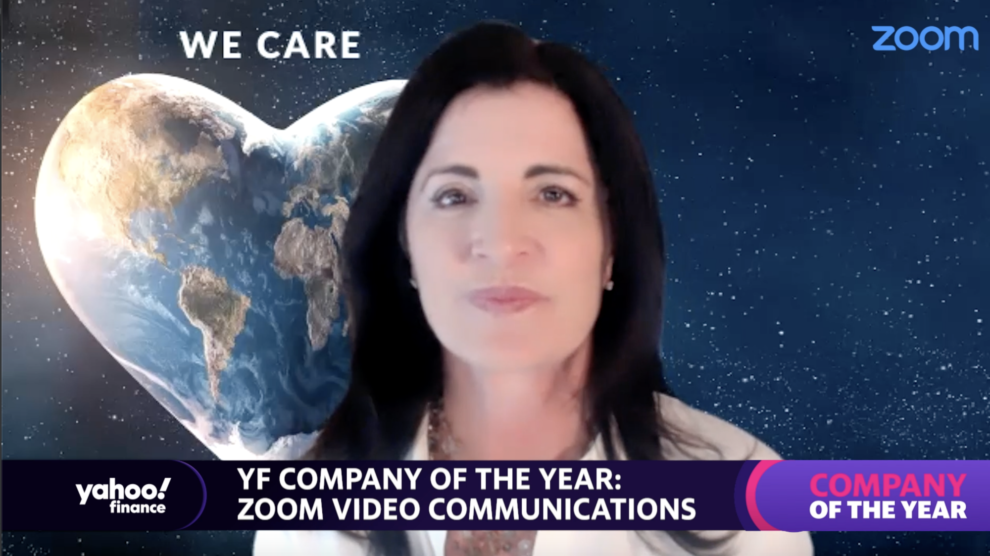Zoom Video Communications CFO Kelly Steckelberg joins Dan Howley to discuss Zoom’s success in 2020 and why it was chosen to be Yahoo Finance’s Company of the Year.
Video Transcript
[MUSIC PLAYING]
DAN HOWLEY: Do you think that sets you up for a better future, knowing that, you know, you’ve already IPOed and now you don’t have to do the whole scramble where investors look and, you know, they don’t see the profitability yet, they don’t see the profitability yet, you have to constantly say it’s coming?
KELLY STECKELBERG: So from, I think, the day that Zoom was founded, we’ve taken a very frugal approach. And you know, we think about– first of all, the capital that we have is not ours. It is our investors’. It belongs to our shareholders, and previously it belonged to the VCs and the early investors in Zoom. And so we always take a very thoughtful approach about how we invest.
And to that, part of our corporate culture and our onboarding is to think about this. So in our offices, for example, on all the screens always running as part of our kind of corporate culture slideshow, there’s a slide that says, if you take one minute to think about spending $1 of your own money, take two minutes to think about spending $1 of Zoom’s money. So we really want to encourage and empower everyone to be thoughtful about how we invest.
And then, of course, we have a whole process and planning cycle around how we prioritize investments. We really focus on initiatives that drive top line growth. So R&D and sales are always a priority. And then looking at opportunities where we can be really efficient in areas like G&A, where we invest in automation. And thinking about how we can avoid hiring, if possible, by doing things in a more efficient way.
And I can’t take credit for that. Like, that is embedded in the company culture. Which is great, because there’s no way that I could do that on my own. It’s really an effort that’s driven in the entire company.
DAN HOWLEY: So you guys just announced your Q3 quarter, the 2021 fiscal year, and you saw $770.2 million in revenue. That was an increase of 367% year over year, and earnings per share were $0.99. That was also a massive increase. I guess, when you look at that, and you think long term, the comparables are going to get tough. Naturally, right? You– you know, that kind of growth is–
KELLY STECKELBERG: Yep, for sure.
DAN HOWLEY: –huge. So how do you then, I guess, temper expectations? Right? Because we saw after the earnings report, people weren’t satisfied with the 367% revenue increase, which– you know, whatever that says. I guess, where do you– where do you see the ability to temper that kind of expectation going forward, when you’ve already seen this massive growth throughout the year?
KELLY STECKELBERG: So what we always say internally, first of all, is we can’t control the stock price. What we can control is our own execution. So that’s what we are really focused on. And thinking about, what does the future look like? And part of that is around, what does the future of work look like? We’re spending a lot of time thinking about, you know, remote work trends, this vision and strategy of work anywhere that I believe is really coming, even in a post-pandemic era.
And we innovate. We announced some great innovations in October at Zoomtopia around things like Smart Gallery, which really enhances the face to face communication experience when you have some employees in the office and you have some that are working from different locations. Things like voice commands and remote reception to help keep people safe as we start to move around the world again.
We also have tremendous growth opportunity in Zoom Phone, which is our cloud PBX product that’s about a year and a half old now. So very early stages still with that. We see tremendous opportunity with international. International grew over 600% year over year in Q3. So it’s growing faster than the US. And with the increased brand awareness that we’ve seen during this pandemic, it’s really opened up markets that would have taken us years and probably millions of marketing dollars to get to. But we’re able to go in and hire talent there directly now, which is really exciting.
And then we have other brand new platforms and products that we announced, again, in October, including OnZoom, which is our event hosting platform. And this is creating an opportunity for really the– the probably million staff– millions of hosts that are on our platform every day that are running small businesses or doing things like fitness classes, and bringing them together with their attendees on a platform that provides a seamless experience for them.
And it will also serve as a directory of events and a discovery mechanism, so that if you wake up in the morning like, hey, I want to take a fitness class, but here I am in Queens and I can’t go outside– how am I going to do that? You can look at OnZoom and you can find what’s available in a time zone that works for you, and very quickly sign up and be in a class.
And so all of those are creating tremendous opportunities for the way that Zoom’s going to be integrated in our lives, even when it’s safe for us to move around in the world again. And all of those have different aspects of growth opportunities ahead. So we’re really excited about the future and what it holds.
DAN HOWLEY: I guess, when you look at– you know, you talk about how the brand awareness exploded, right? You know, it was a big IPO. A lot of people were looking forward to it. But the average consumer might not have known, right, if they weren’t working in an office at that point.
And now, you know, you– I was talking to my editor about this and, you know, she’s– she mentioned that people don’t ask, do you want to get a drink? They go, do you want to– do you want to Zoom? Yeah, we do that. My wife and I do that with our friends. Do you want to hop on a Zoom? And you know. So, you know, Skype existed. Microsoft Teams was in existence. Google Meet was in existence. So it was hangouts, it was whatever they were calling it at that point. But there were big name competitors.
So how do you kind of explain the way that Zoom went from, you know, known in the enterprise space to this consumer service now, where originally it wasn’t necessarily there, and– and how do you continue to go along with that?
KELLY STECKELBERG: So everything that we do at Zoom is focused on delivering happiness to our customers and our employees. And– and the way we do that from the customer perspective has really been focusing on ease of use, as well as reliability of the platform. And so you’re absolutely right. Before this pandemic, we were really known in the enterprise space and the– you know, the B2B space, but not nearly as well in the individual or consumer space.
And I think because it’s so easy to use, as we saw schools start to adopt it. It’s easy enough for a kindergartener to get on and know how to navigate around. It’s also simple enough for, you know, grandparents to feel comfortable getting on and reading stories with their grandchildren.
And so I think it was that, combined with the scalability of the platform, that– that held up and was there and able to serve, you know, really, the millions of new consumers and users that came to our platform in a very quick period of time, is what led to that extreme growth and increase in brand awareness.
Just to give you some perspective on growth, if you look at last December, we were averaging 10 million daily participants. And in the spring, we announced that that had grown to over 300 million daily participants. And so in a very short period of time, we saw a dramatic increase in usage. And I think it’s the scalability of the platform that allowed us to do that.
DAN HOWLEY: When– when you look, you know, at the different types of usage, I mentioned– mentioned school. We were doing a separate breakout piece on Zoom in education, how, you know, universities had worked with Zoom, and then, you know, now it’s K through 12. I think my nephew might use Zoom schools, and he’s like three years old. So as you said, it is easy enough for kids to get on there and– and communicate through it.
My poor parents have to do construction paper turkey hats for Thanksgiving for them, but still, you know, it works. I guess–
KELLY STECKELBERG: How sweet!
DAN HOWLEY: With– it’s– it’s amazing. When you look at the telemedicine industry, that was something, I think, that felt very much still in its infancy until it was forced to grow up real quick, where people were nervous about going to hospitals because they thought they would get sick. And Zoom became something that a lot of people relied on to– to talk to their doctors. I mean, I use Zoom calls. My– my parents use Zoom calls for their own checkups.
So I guess how did you see that developing throughout the pandemic? Because that was something that existed beforehand, right?
KELLY STECKELBERG: It did. So we absolutely– health care has been one of the key verticals that we have focused on for a long time. We support HIPAA compliance in both Zoom Meetings and Zoom Phone and of course, that’s what’s really important to give confidence to health care providers to be able to talk to their clients and their patients and ensure that they’re doing it in a very safe, secure, and private way.
And that’s what we all want to know, right? That we don’t want to ever have to worry about the security of the platform when we’re having these really sensitive, important discussions with our health care providers. And that’s exactly what Zoom provides. Combined with the ease of use that all, you know, again, all ranges and ages of patients and clients can easily join a meeting.
DAN HOWLEY: Is– is there anything where you have to talk to insurers, or have you talked to insurers? Is that something that you guys work with? And I guess, are– are competitors something like Teladoc or Amwell, or do you work with them? How does that work?
KELLY STECKELBERG: Yeah, so our strategy is we’re really more of a horizontal platform that supports the need of then the other app developers that want to build on top of it. So for example, we wouldn’t talk to the insurers because we’re not the one providing the service itself. We’re just there to facilitate it so that we make it really easy for a doctor and a patient to come together.
And then, of course, we have our App Marketplace that allows developers then to build specific verticalized apps on top of our horizontal platform.
DAN HOWLEY: So if there’s something like a, say, regular generic doctor’s appointment, your primary care physician, there may be an app available that would plug into Zoom that they would then use? And then Zoom would be the video platform that they work through.
KELLY STECKELBERG: Exactly right. So maybe they’re using one of the apps in the App Marketplace to do things like scheduling. And then that facilitates, you know, everything leading up to the meeting, and then you join the meeting with your health care provider. And then maybe afterwards, there’s a follow up for your next appointment or something. But we’re really at the core of bringing people together for the meeting itself.
DAN HOWLEY: OK. And I guess, as far as, you know, working at Zoom and what it’s been like, I know that you guys obviously had to go on a hiring spree, I’m sure, because the kind of growth kind of necessitates that. But what have you seen, I guess, as far as going from a company that was known in the IT space to a company that’s now, you know, a lifeline to a lot of people as far as connecting and staying connected? And how has that impacted employees? Is there, you know, a greater sense of– of importance put on their own work? And how are they working from home in the same kind of conditions?
KELLY STECKELBERG: Yeah, so we sent our employees home in early March, and the advantage, of course, that we had is that we all live on this technology every day. So we didn’t have to adopt to that. You know, March 15, the world changed for us when there started to be this dramatic increase in demand and need for the product.
And first of all, a huge testament to the commitment and sheer will of our Zoom employees, who worked tirelessly for our first couple of months to do everything we could to make sure that every customer and every prospect that wanted Zoom or needed Zoom had access to it.
And as you said, we’ve hired a lot. We have about a third of our workforce today has been hired during the last nine months, which means they’ve never stepped foot in an office. They’ve never met their manager or their teammates in person. And so to ensure that we are able– you know, our culture is a very important part of Zoom.
And so, to ensure that we’ve been able to continue that during this time, our People Experience team has come up with a complete virtual onboarding experience, and the leadership team, we’ve all become more thoughtful and deliberate about connecting with our teams. We’re being very thoughtful about boundaries to ensure that we give people, you know, some– some space. It’s really easy, in this work from environment, to have your days extend. So being very thoughtful about that.
One of my favorite– I always use this example. One of my favorite examples of that is one of our employees taking a Friday off and putting on her Out of Office that she was in a backyard campout with her kids. And I love that. Even though we’re not traveling, we all need to make time to spend– for those experiences. And the leadership team, trying to really lead by example around that.
And you know, we at Zoom– I think I speak for the entire company– we are very humbled and proud of the opportunity that we’ve been given during this time to support connection in the community and try to minimize disruption as much as we can in– in learning and connected. I love hearing about you and your wife, you know, meeting with your friends, families coming together.
We have heard countless stories of, you know, adoptions and weddings and engagements, bar mitzvahs. And then even end of life ceremonies. And all of those are beautiful experiences that we feel so amazingly proud to be the platform that people have let into their lives to bring them together.
DAN HOWLEY: I guess, you know, when– when it comes to using Zoom and– at a certain point, do you– do you have to tell people how to– you know, employees how to help with the fatigue of always being on screen or talking to people on screen? How– how does that kind of balance out?
KELLY STECKELBERG: Well, I think, like all employers around the globe right now, we’re all searching for ways to make sure that we are supporting our employees in the best way possible. So a couple of things we’ve done– I talked about earlier being very thoughtful about, first, workload. We are hiring as quickly as we can. Again, our employees have done everything they can to support our customers during this time, and we’re adding resources where we need as quickly as possible. Really being thoughtful about boundaries.
We’re also doing fun things, like we have a– we have a team at Zoom called the Happy Crew, and the Happy Crew is exactly what it sounds like. They’re there to help support in delivering happiness to our employees every day. They’ve sent out some really cute surprises every month. We had one that was all about setting up your work from home environment with a mug and some exercise bands, things like that, just to make us all more productive and healthy during this time. They sent out one for Diwali and we had an online Diwali celebration, which was amazing. I loved it. It was so beautiful.
So things like that, as well as we did– we used to have a monthly gym membership allowance that everybody could have. As most gyms are not accessible to people during that time, we’ve now converted that over to a more broad-based sti– monthly stipend that people can use for things like food delivery, grocery delivery.
And we’ve heard from our employees, even that helps. You know, not having to make dinner a couple of times a month is– really helps relieve the stress, because they’re all trying to deal with, you know, teaching their– their children at the same time they’re working full time, at the same time trying to maintain a household. So we’re always looking for ways that we can continue to support employees like that.
DAN HOWLEY: And then just finally, I know we had– we won’t be able to speak with Eric, but I just want to, you know, kind of get a sense of him and how he’s working. You know, I know he’s kind of been focused on the business for day one, probably, obviously. But since it’s kind of taken off, that’s got to be what you all are doing.
So I guess when you, you know, look at something like that, is it that he is very focused all the time on the business, and how does that kind of communication work? Do you guys work hand in hand as an executive team? What is that kind of relationship like?
KELLY STECKELBERG: Yeah. So we have a couple of modes of communication within the organization. We do– Eric has a weekly staff meeting where his– instead of his direct reports, we all come together, and that’s where we talk about initiatives, certainly review, like, the forecast every week, things like that, as well as hiring and how that’s all going.
And we have– we leverage our own internal chat product extensively and stay in touch very– on a day to– you know, key day to day items on an ongoing basis. I think in general, Eric’s passion is certainly around our product, and he is a true visionary who is always thinking about how do we drive the product forward.
And he is also super passionate about our customers as well, and spends a lot of time with customers, listening to them, helping, of course, sell to new prospects. But also just thinking about what is it that we can do to continue delivering happiness to our customers?
And, you know, he really challenged all of us every day to think about every decision that we make at Zoom from the customer or the employee’s perspective. And if you keep that in mind, you’re going to come to the right decision. If you’re doing the right thing for your customers and employees, you’re generally doing the right thing for the business.
DAN HOWLEY: How is it, just– you know, at this– promise, last one– when you reach out to customers, you guys have to talk to customers, is it something that’s changed since you’ve gotten so much larger? Is it more difficult to stay in touch, or is it still the same, perhaps, intimate relationship that existed prior?
KELLY STECKELBERG: Yeah, I think what has grown commensurate– or we’re working on having it grow commensurate with the growth in our customer base– is things like our sales organization, our customer success organization, our technical support team, our sales engineers to ensure that we have the teams that are there to continue to support our customers, ensure that their needs are being met, and also, as you say, stay connected to them.
You know, it– we’re– we’re playing catch-up for sure, as we saw such a dramatic increase in our customer base in Q1, Q2, and into Q3, but we are focused on that, and certainly hiring as quickly as possible.







